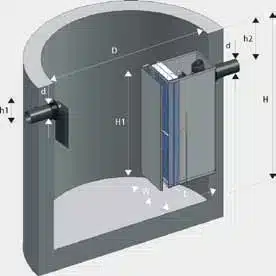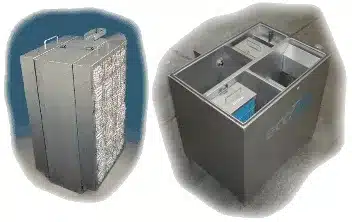Can underground tanks really be the unsung heroes of environmental protection? In Michigan Below Ground Oil Water Separators are proving to be just that. These hidden champions play a crucial role in industrial wastewater management. They protect our precious water resources from harmful pollutants.
Michigan’s industries count on these underground tanks to follow strict environmental rules. These oil-water separators can handle different types of hydrocarbons. They make sure the water that comes out is clean, meeting the North American limit of 10 Parts per Million (PPM).
Thanks to advanced technology, some separators can get water down to 5 PPM. Some can even get it to 0.1 PPM for tiny amounts of emulsified oil. This level of performance is key for good stormwater management and keeping the environment safe in Michigan.
Key Takeaways
- Freytech Inc. Below ground oil water separators are key for treating industrial wastewater in Michigan
- These systems can effectively separate various hydrocarbons from water
- Advanced separators achieve separation efficiencies as low as 5 PPM
- Underground installation helps with space management and looks better
- Using oil-water separators right is vital for following environmental laws in Michigan
Understanding Below Ground Oil Water Separators in Michigan
Below ground oil water separators are key in Michigan for treating wastewater. They help keep water clean and stop pollution in industrial areas.
Definition and Function of Oil Water Separators
Oil water separators use gravity to take oil out of water. They are important in industrial wastewater treatment. These devices sort oil droplets by size and density, making the water cleaner.
Importance in Industrial Wastewater Treatment
In Michigan’s industrial world, these separators are crucial for stopping spills and controlling water pollution. They help factories, refineries, and plants follow clean water laws. By taking out oil and solids, they protect local waterways and ecosystems.
Michigan-Specific Regulations and Compliance
Michigan has strict rules for below ground oil water separators. These rules match federal and state clean water laws. Companies must make sure their separators follow American Petroleum Institute standards. They need regular checks and upkeep to avoid fines.
Designing these separators right takes into account oil globule size, water temperature, and flow rates. This makes sure they work well and help businesses meet Michigan’s environmental standards for water quality and pollution prevention.
Benefits of Below Ground Installation for Oil Water Separators
Installing oil water separators underground has big perks for businesses. It helps them meet environmental laws and prevent spills. These tanks save space, making room for other important things.
They stay safe from bad weather. Being underground, they don’t get damaged by extreme cold, rain, or snow. This means they last longer and work well in all kinds of weather.
Looks matter too. These underground tanks keep the area looking neat and professional. This is key for businesses in places with strict looks rules or those wanting a top-notch image.
Steel and concrete are often used for these underground tanks. They’re strong against soil pressure and last a long time. Many setups also have extra systems to catch leaks and manage stormwater, helping protect the environment.
But, there’s a move towards above-ground options too. These are easier to get to for upkeep and don’t have the space issues of underground ones. Companies should think about what they need and what’s required by laws when picking a solution.
Key Components of Michigan Below Ground Oil Water Separators
Below ground oil water separators are key in treating wastewater and controlling water pollution. They have several important parts that work together. These parts help separate oil from water in industrial wastewater.
Inlet Section with Diffusion Wall
The inlet section has a diffusion wall. This wall slows down the wastewater flow. It makes separating oil and water better.
The diffusion wall spreads the flow evenly across the separator. This makes the treatment process more efficient.
Separator Channel and Oil Retention Baffle
In the separator channel, oil and water are separated. Oil goes up to the top while water goes down. An oil retention baffle keeps the separated oil from mixing back with the water.
This ensures that contaminants are removed from industrial wastewater effectively.
Outlet Section and Additional Options
The outlet section lets clean water leave the system. Many separators have extra features to improve their work. These can include trash screens, skimmers, and conveyors.
Some systems also have safety features like nitrogen blanketing and carbon filtering. These meet environmental rules.
Design Considerations for Below Ground Oil Water Separators
Designing Michigan Below Ground Oil Water Separators requires careful planning. First, analyze the influent to pick the right system for treating industrial wastewater. This helps meet environmental standards and follow clean water laws.
Skimming system design is crucial for efficiency. Engineers must figure out the drag conveyor torque needs for the best performance. Choosing the right components is also key, making sure they can handle the wastewater treatment process.
Many Michigan facilities use API 421 design specs for their oil water separators. These guidelines bring in new tech to improve separation. Adding parallel plate packs can increase the surface area, leading to better oil removal and more wastewater flow.
Custom designs cater to unique industrial needs. These solutions include process features and site-specific setups to tackle specific wastewater issues. By focusing on these design elements, Michigan industries can make sure their Below Ground Oil Water Separators meet both legal and operational demands.
Installation Process and Best Practices
Installing below ground oil water separators needs careful planning and execution. It involves several key steps for proper functionality and to follow environmental laws. Let’s look at the main parts of this process.
Site Preparation and Excavation
The first step is to prepare the site well. This means surveying the area and marking where utility lines are. Sometimes, hydro-excavation is needed to safely dig around underground stuff. After getting the site ready, excavation starts, making room for the separator and its base.
Tank Placement and Piping Connections
Next, the tank is put in place and connected as needed. This includes setting up auger cast-in-place piles and foundations for the separator. Once the tank is set, workers connect the pipes, add platforms, stairs, and other parts like coalescers and outlet baffles. These parts are key for managing stormwater and preventing spills.
Safety Measures and Environmental Precautions
Safety is the top priority during installation. Workers must follow strict rules to protect themselves and the environment. This means using the right protective gear and avoiding soil pollution. Following these steps makes sure the installation meets environmental laws and helps prevent spills.
These separators are crucial in storm water systems. They process runoff to meet the US EPA’s Clean Water Act standards. With effective oily water treatment, facilities protect the environment and dodge big fines.










